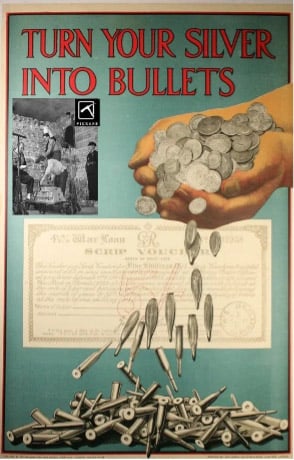Silver has been used for thousands of years as ornaments and utensils, for trade, and as the basis for many monetary systems. Of all the metals, pure silver has the whitest color, the highest optical reflectivity, and the highest thermal and electrical conductivity.
Backstory.
Whenever you read some precious metals expert discussing the industrial uses of silver, here is the typical spiel that goes: "Silver is essential in jewelry, electronics, medical, solar, electric vehicles, and Green Energy storage systems (i.e., batteries)."
Very good, Captain Obvious, but it's my fervent belief that military and aerospace usages of silver gobbles as much as a third of all silver used by industry.
Five Government Agencies Suppressed Silver Usage Data… Why?
In fact, the U.S. government, the Department of Defense, the Department of Energy, the Department of Interior, and the U.S. Geological Survey collectively gaslit us villagers and stopped reporting on silver inventories starting around the 1995-1996 timeframe.

For most of the 20th century, the United States Bureau of Mines (USBM) was the primary United States government agency conducting scientific research and disseminating information on the extraction, processing, use, and conservation of mineral resources.
The Bureau was abolished in 1996. (Coincidentally, at the same time, the Department of Defense started pretending silver was not important to them.)
Let's further examine and start documenting massive uses of Silver that are not on the historical record (we will let you draw your own inferences).
Silver is probably the world's most critical and strategic mineral. (Yet it’s somehow not considered critical by the U.S., even as the Department of Energy has classified other metals as critical.)
Massive and unrecorded uses of silver in:
- Bombs
- Nukes and nuclear-positioned Submarines
- Shells
- Satellites
- Tanks
- Missiles
- Bullets
- Torpedoes
- Conventional Submarines (not of the nuclear variety)
- Rockets
- and dozens of other military applications
In 2021, the U.S. imported 6,500 metric tons of silver.
The United States is 79% import-reliant for its silver needs. From 2017 to 2020, Mexico provided 47% of these imports, followed by 23% from Canada, 4% from Chile, 4% from Poland (and the remaining 22%, we can assume Russia was the heavy importer among this opaque other 22%).
The 2023 Final Critical Materials List, published by DOE, has determined the following are Critical materials for energy:
Aluminum, cobalt, copper, dysprosium, electrical steel, fluorine, gallium, iridium, lithium, magnesium, natural graphite, neodymium, nickel, platinum, praseodymium, silicon, silicon carbide, and terbium.
The Secretary of the Interior, acting through the Director of the US Geological Survey (USGS), published a 2022 final list of critical minerals that includes the following 50 critical minerals:
Aluminum, antimony, arsenic, barite, beryllium, bismuth, cerium, cesium, chromium, cobalt, dysprosium, erbium, europium, fluorspar, gadolinium, gallium, germanium, graphite, hafnium, holmium, indium, iridium, lanthanum, lithium, lutetium, magnesium, manganese, neodymium, nickel, niobium, palladium, platinum, praseodymium, rhodium, rubidium, ruthenium, samarium, scandium, tantalum, tellurium, terbium, thulium, tin, titanium, tungsten, vanadium, ytterbium, yttrium, zinc, and zirconium.
I had to read this dozens of times, and thank God it was alphabetized! (Silver would fall in between scandium and tantalum.)
Gold isn't on the list either. Humm, I see a pattern here.
What is one of the first things a silver investor learns about silver…how necessary silver is used in industrial sectors, including energy systems.
Silver Is Critical to Nuclear Power Generation Too
On August 29, 1942, Secretary of War Henry Stimson formally requested silver from Secretary of the Treasury Henry Morgenthau Jr. The silver was then processed into silver wire and transformed into large coils, which played a crucial role in the uranium enrichment process.
These coil strips were transported from New Jersey to Wisconsin by rail, typically in shipments consisting of six sealed railcars, with each shipment containing around 300 coils. To ensure their security, the coils were continuously guarded, with three armed guards accompanying them in a dedicated caboose on each journey.
At the Allis-Chalmers Manufacturing Company in Milwaukee, the coils were unwound and interconnected using silver solder to create larger reels. These larger reels were then fed into a specialized machine, which wound them around the steel bobbins of the magnet casings. Between February 1943 and August 1944, 940 magnets were wound, each containing approximately 14 tons of silver. In sum, this amounted to well over 400 million ounces of silver.
Following this, during the global nuclear arms race, nations conducted a total of 2,088 atomic detonations, each utilizing a conservative estimate of 1,000 ounces of silver per blast. This amounted to 2 million ounces of silver vaporized during nuclear tests alone.
But that does not account for the current stockpiles of nuclear warheads in the world's various military arsenals, including those stored in silos, submarines, buried in mountains, or incorporated into missiles (each Tomahawk has 500 silver ounces, for example), bombs, shells, satellites, submarines, torpedoes, tanks, fighter aircraft, night vision goggles, and other military equipment.
